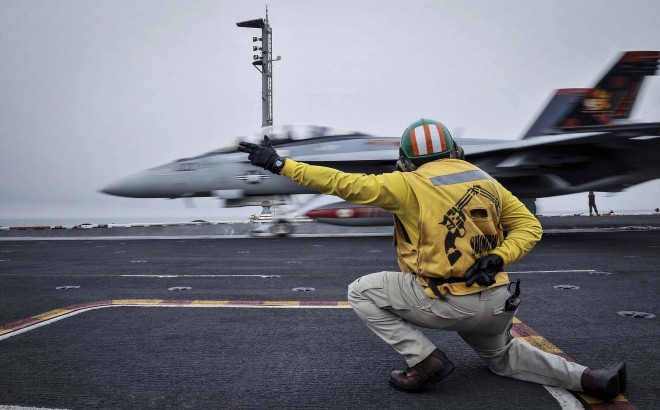Saudi coalition ends Yemen air war, but keeps options open

In this Wednesday, April 15, 2015 image released by the U.S. Navy, a shooter launches an F/A-18F Super Hornet, assigned to the Red Rippers of Strike Fighter Attack Squadron 11, off the flight deck aboard Nimitz-class aircraft carrier USS Theodore Roosevelt in the Fifth Fleet area of operations. he U.S. Navy has dispatched USS Theodore Roosevelt toward the waters off Yemen to join other American ships prepared to intercept any Iranian vessels carrying weapons to Houthi rebels, U.S. officials said on Monday. AP
RIYADH, Saudi Arabia – A Saudi-led coalition declared an end Tuesday to four weeks of air strikes in Yemen, saying the threat of Iran-backed rebels there had been removed and that operations are entering a political phase.
However, it left open the option of resuming strikes if the movements of the Houthi Shiite rebels warrant it, while adding that a naval blockade on the strategic country at the tip of the Arabian Peninsula will continue.
Shiite Iran welcomed the move, calling it a “step forward” toward resolving the conflict, while there was no immediate reaction from the Houthis.
US aircraft carrier
But the announcement came as a US aircraft carrier was headed to the Arabian Sea, with Washington saying it was monitoring Iranian vessels suspected of carrying weapons to the rebels in violation of a UN embargo.
Article continues after this advertisementThe coalition has “ended Operation Decisive Storm based on a request by the Yemeni government and President Abedrabbo Mansour Hadi,” its spokesman, Brigadier General Ahmed al-Assiri, said in Riyadh.
Article continues after this advertisementThe operation, which began March 26, will continue until midnight.
A coalition statement said the next step would aim to resume the political process in Yemen, delivering aid and “fighting terrorism” in the country, home to a deadly Al-Qaeda franchise.
Diplomatically, the coalition would seek “international cooperation… to prevent arms from reaching” the rebels.
Confront Houthis
It would also “confront movements and military operations of Houthi militia and their allies… to prevent them from using the arms stolen from military camps or smuggled from abroad,” it added.
Coalition forces would “continue to protect civilians in Aden and target any attempts to carry out operations” by the militia,” Assiri added.
Speaking in Tehran, foreign ministry spokeswoman Marzieh Afkham said the “establishment of a ceasefire and a stop to the killing of innocent and defenceless people is a step forward.”
In remarks carried by state news agency IRNA, she said she hoped humanitarian aid would be sent soon and that “a situation for talks between Yemeni parties and groups for formation of a comprehensive government is resumed.”
Americans ‘preserving options’
But amid reports of a nine-ship Iranian convoy in the area, the US Navy said it was sending in the USS Theodore Roosevelt and guided-missile cruiser USS Normandy.
Pentagon spokesman Colonel Steven Warren said media reports suggesting the Americans were preparing to prevent the Iranian convoy from reaching Yemen if it was carrying arms were “a bit over-cranked”.
“We don’t know what the Iranian convoy of ships plans to do, but we are watching them,” Warren said. “By having American sea power in the region, we preserve our options.”
Located on key shipping routes and bordering oil-rich Saudi Arabia, Yemen was plunged into chaos last year when the Houthis seized Sanaa.
The Saudi defence ministry said the air strikes had managed “to successfully remove threats to Saudi Arabia’s security and that of neighbouring countries”.
The UN health agency said more than 900 people have been killed since the strikes were launched against rebels clashing with pro-government forces.
The coalition of Sunni Arab nations launched the strikes in a bid to restore the authority of Hadi, who fled to Riyadh as the Shiite rebels advanced on his southern refuge Aden.
21 dead in Aden clashes
The coalition says it has carried out more than 2,000 strikes, gained complete control of Yemeni airspace and knocked out rebel infrastructure.
In Aden, 21 people, including 13 civilians, were killed in fighting between pro-Hadi forces and rebels, sources said.
In the central province of Ibb, several civilians were killed in a strike targeting rebel air defence missiles in a residential area, witnesses said.
Farther south in Shabwa province, tribal sources reported several deaths in raids and fighting.
The World Health Organization said the violence had killed 944 people and wounded 3,487 as of April 17.
But the true numbers are likely higher, as many people are not making it to hospitals.
In Riyadh, a Western diplomat said he thought it was a “good time for the Saudis to get out of this,” though the political objectives had not been achieved.
“The Houthis are still there where they had been before,” said the diplomat, who asked not to be identified.
At the same time, Al-Qaeda has taken advantage of the chaos to seize swathes of territory in Hadramawt province in the southeast, including its capital Mukalla.
Yemen has long struggled with deep tribal divisions and an insurgency by Al-Qaeda in the Arabian Peninsula (AQAP), considered by Washington as the jihadist network’s most dangerous branch.